Socialter defines creativity as "the Grail of the 21st century" and the World Economic Forum places it at the heart of the four key competencies of our time with critical thinking, the art of communicating and collaborating. Essential to the survival and development of the company, it is essential to promote and integrate it into the corporate culture.
What is creativity?
It is the ability of a person or group of people to design and implement a new concept, a new object or to discover an original solution to a problem. Creativity is at the origin of invention (when used for a product or service) and innovation (when this invention applies to a market).
Are we all creative?
In the collective unconscious, creativity appears as the prerogative of some solitary geniuses, often cursed, endowed with innate gifts and disconcerting facilities. In reality, each person has a creative potential often under-exploited or constrained by conformism, pessimism, fear of failure, family or social judgment, education.
What are the characteristics of the creative people it is up to us to develop?
- self-esteem in any event;
- determination, commitment and perseverance at all times;
- an unlimited curiosity to embrace all fields of knowledge, observation or the human condition;
- high speed of information processing of any kind associated with a taste for complexity;
- a flash resolution of problems associated with an almost automatic generation of ideas;
- an ability to imagine other worlds, other systems, other logics.
The thought of a creative is both:
- analogue (linked to the free association of ideas and images coming from different and often compartmentalized universes),
- divergent (original, fluid and flexible),
- original: free from gender stereotypes,
-deconcerting: capable of operating radical reversals.
The great enemies of the creative are fatigue and stress, the search for perfection, specialization, the "academic" spirit, the routine and the lack of openness to the world.
Creating something that has never existed requires enthusiasm, experimentation and a detachment of knowledge and the past. It's an open, free-spirited attitude that feeds on everything and is driven by challenges.

How to become more creative?
Many exercises that promote idea generation and problem solving exist. Nevertheless, developing a creative mindset is the key for those who wish to exploit their creative potential, namely:
- absorb everything and be open to new experiences to find inspiration and promote the analog process;
- constantly ask questions to deepen your knowledge;
- to think like a child, to free oneself from schemas, constraints and forbidden, to move away from reason;
- to question and reconsider the gains;
- hear all points of view to develop new paths and new interactions;
- alternate creative phase and mental rest phase;
- make sleep his ally to develop the unconscious thought;
- take a distance on things to implement the imagination;
- develop one's sense of humor, have wit;
- take risks, consider failures as a way to progress and develop boundless determination;
- never censor ideas;
- develop the fun aspect of creation by moving from cock to donkey, associating, taking the opposite, playing the paradox.
Even if the great creations are generally the fact of an individual connected to his desires, his thoughts, his inner challenges, the innovation is often a collective act, the fruit of a creativity and an original action of team. Theoretically, the creativity of a group of individuals together should have infinitely greater potential than that of an isolated person. In practice, the optimization of "collective intelligence" involves creating the conditions for group creativity and setting up the organization that allows the individual creative process to be replicated at the team level.
Different approaches such as design thinking promote the spread of the culture of creativity in the company and the organization of the different stages of preparation, incubation, generation of solutions and validation. In business, creative improvisation with decision and immediate implementation does not exist. On the other hand, the respect of the different creative stages can allow the emergence of complementarities and a creative team spirit that will allow to interiorize the creative process and accelerate the group innovation.
To remain competitive and foster innovation, one of the means to remove the resistance to change of employees (seeing no personal interest, considering not having the required skills or feeling threatened by the unknown) is to set up a culture of creativity applied in the rules of the art.
By restoring trust, enhancing value, by collaborating on joint projects in which everyone contributes, by making a difference in the collective fruits, the company will gain in flexibility, adhesion and dynamism, essential in an open economy more and more globalized before meet increasingly individualized needs.
Article proposed by:



 Nicolas Sarazin
Nicolas Sarazin